With the first batch of UEFA Nations League matches now complete, it is a great time to look at the squads ahead of the World Cup in Qatar. The Nations League provides a glimpse into each of the teams before the winter, as they are pitted against opponents of similar calibre.
There have been some interesting results in each of the groups but the most significant event is that France are winless at the bottom of League A Group 1 having only picked up two points. The 2018 World Cup winners are still one of the strongest teams in Europe, as their ranking third in the FIFA ranking suggests, and would have been expected to win the majority of their group matches after winning the tournament in 2020-21.
This article will be a tactical analysis of the France Nations League campaign in the form of a team scout report. It will be an analysis of the reasons behind their disastrous form, from managerial tactics to players’ communication.
The Group

After the first four matches, France sit at the bottom of their group having drawn two matches away from home against Austria and Croatia. Arguably, France have the weakest group in League A with Denmark the only opponent within the top 15 of the FIFA rankings. With this in mind, for Les Bleus to have not won one game out of the four is astonishing.
Their results have been better away as they managed to get 1-1 draws against both Croatia and Austria. The most worrying statistic for Didier Deschamps will be the two losses at home by one goal against Denmark in their 2-1 defeat and Croatia 1-0 in the Stade de France.
With only one team qualifying for the knockout stage of the Nations League, France will be unable to progress with only two games remaining leaving them on just eight points with two wins. The best option now for Deschamps is to settle on his squad ahead of the World Cup using the two matches in September.
Squad
The France squad could be the best team on paper in the tournament with talent in every position. Even the bench for the national side could arguably have more top names than many of the teams at the Nations League, which is why this poor string of results is so unbelievable.
As you can see from the graphic, within the France squad there are some of the best players in the world, all of which are playing in the top leagues and fighting for trophies year on year.
Although France have all this talent, getting them into a starting 11 is super challenging, as Didier Deschamps has discovered. The starting 11 has been rotated very frequently within the nations league, as only Aurelien Tchouaméni and Antoine Griezmann have made appearances in every match.
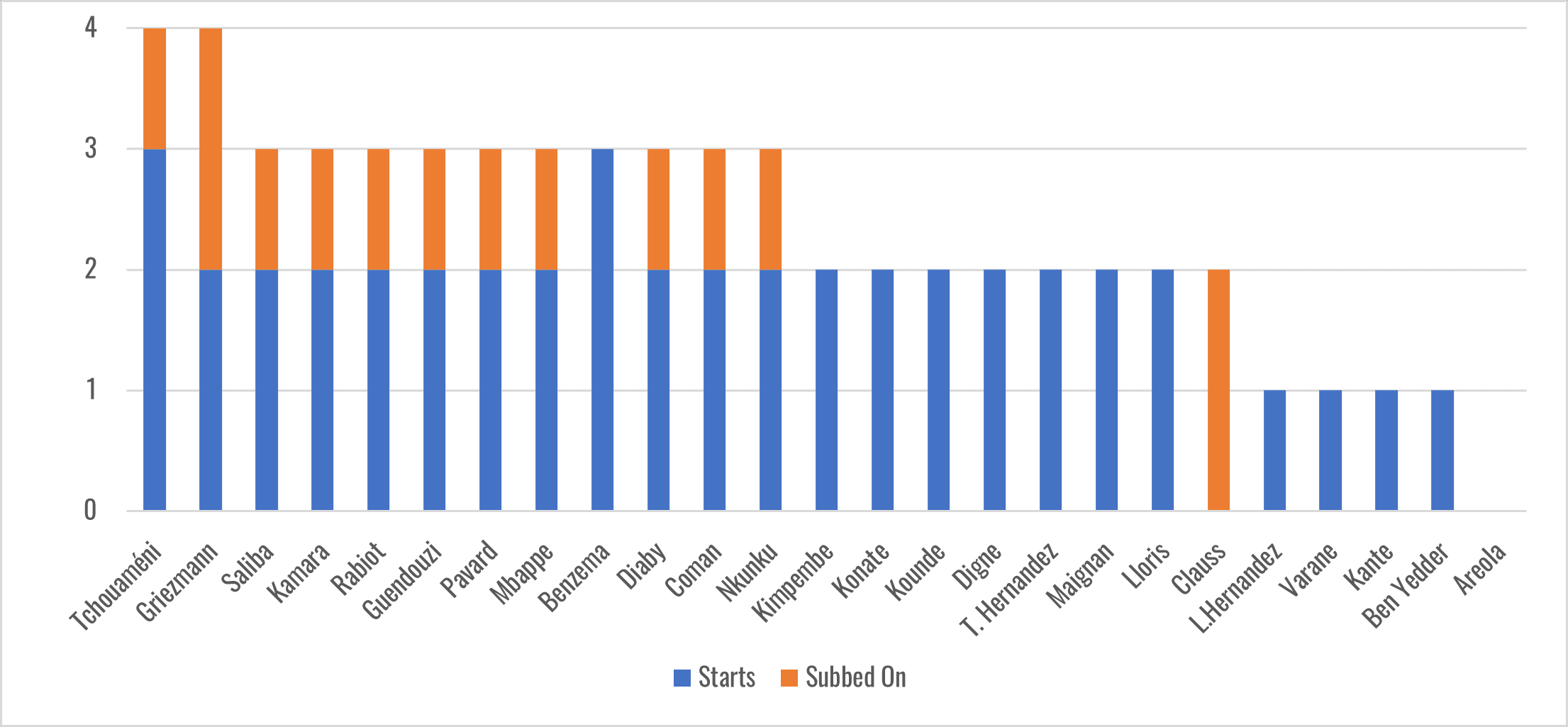
This is a huge problem for the management of the France national team as no big names will be happy to sit on the bench if they are starting week in and week out with their domestic clubs, but having a consistent team is important to picking up momentum and getting a system to work. As 19 different players have started at least two matches in the tournament, there has been no chance for partnerships in the side to be made and it looks like all the players are individuals on a trial for the World Cup squad, not a team looking to compete at an international tournament.
With the World Cup only around the corner, perhaps Deschamps is looking for his best starting eleven in readiness for the ‘bigger’ tournament in world football, with it being the pinnacle of all international tournaments. Although this may be the case, the poor form is not just down to the management. The players themselves don’t look to be putting in the effort, maybe due to the huge amount of fixtures players must play in the modern era, or perhaps there are some issues between the players in the squad.
The main cause for the form does lie on the former Monaco boss Didier Deschamps, as it is not only the players that he is changing each game but also the formations during the match. So far in the Nations League, France have used three different formations across the four matches, as the World Cup winner as player and manager looks for the perfect recipe for accommodating all of the players into one team.
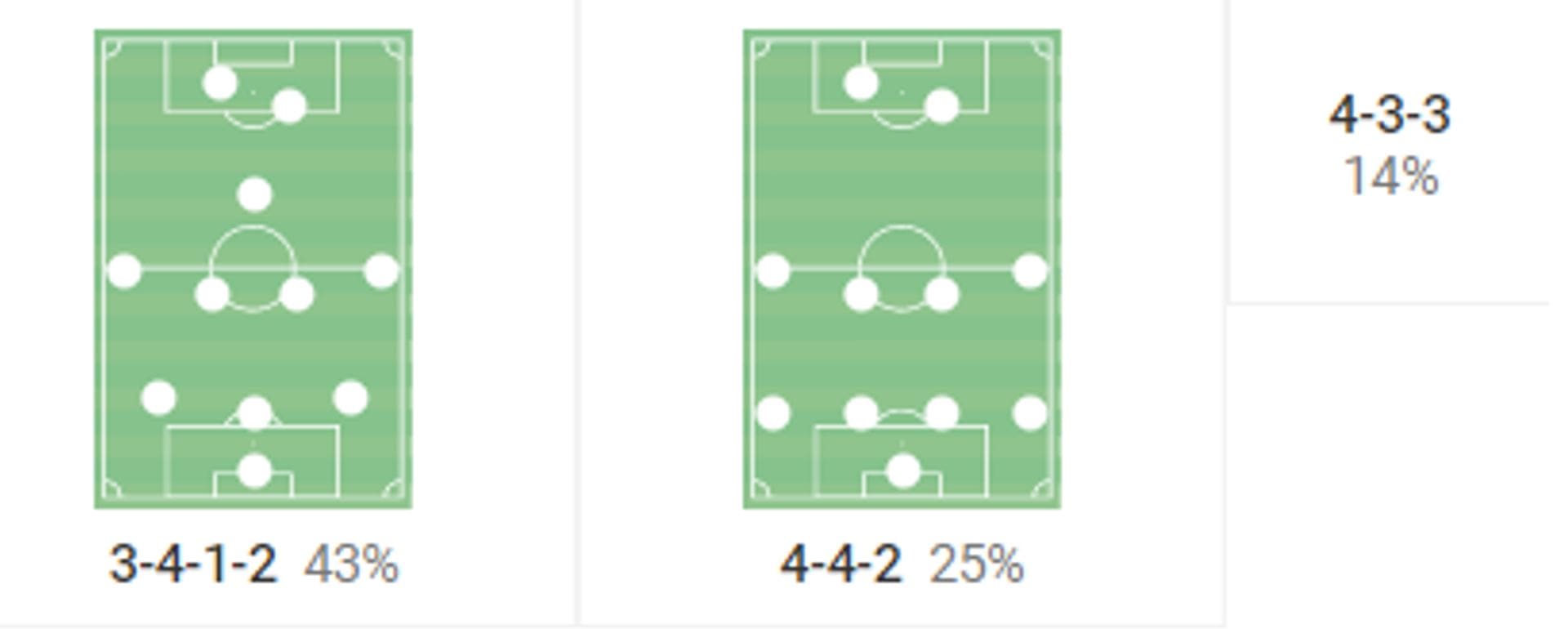
Deschamps has preferred a 3-4-1-2, with it suiting the strong centre-back options, the full-backs/wide players in the side to get higher up the pitch and it allows for the potential use of three strikers in the side. The 4-4-2 looks to have a focus on the width with wide midfielders and full-backs in the side while losing the player in between the midfield and strikers between the lines. The 4-3-3 is a mix of the two other formations with the wide midfielders as wingers with the sacrifice to only have one number nine.
On the pitch
The effects of this inconsistency are clear when you break down how France are set up structurally during a match. The defensive and attacking phases of play are both hindered greatly by the rotations in the squad and are clear when looking closely during a match.
Attack
In attack, the for France is the same in all of the systems as they look to play out from the back, through the thirds. However, as simple as the top teams make this look, France are not able to execute it consistently enough to wear teams out for the duration of a match.
The bulk of the problems in possession for France are in two main phases of the play but stem across the whole team. The build-up play is where it all starts with the ball being circulated across the back four or three depending on the formation.
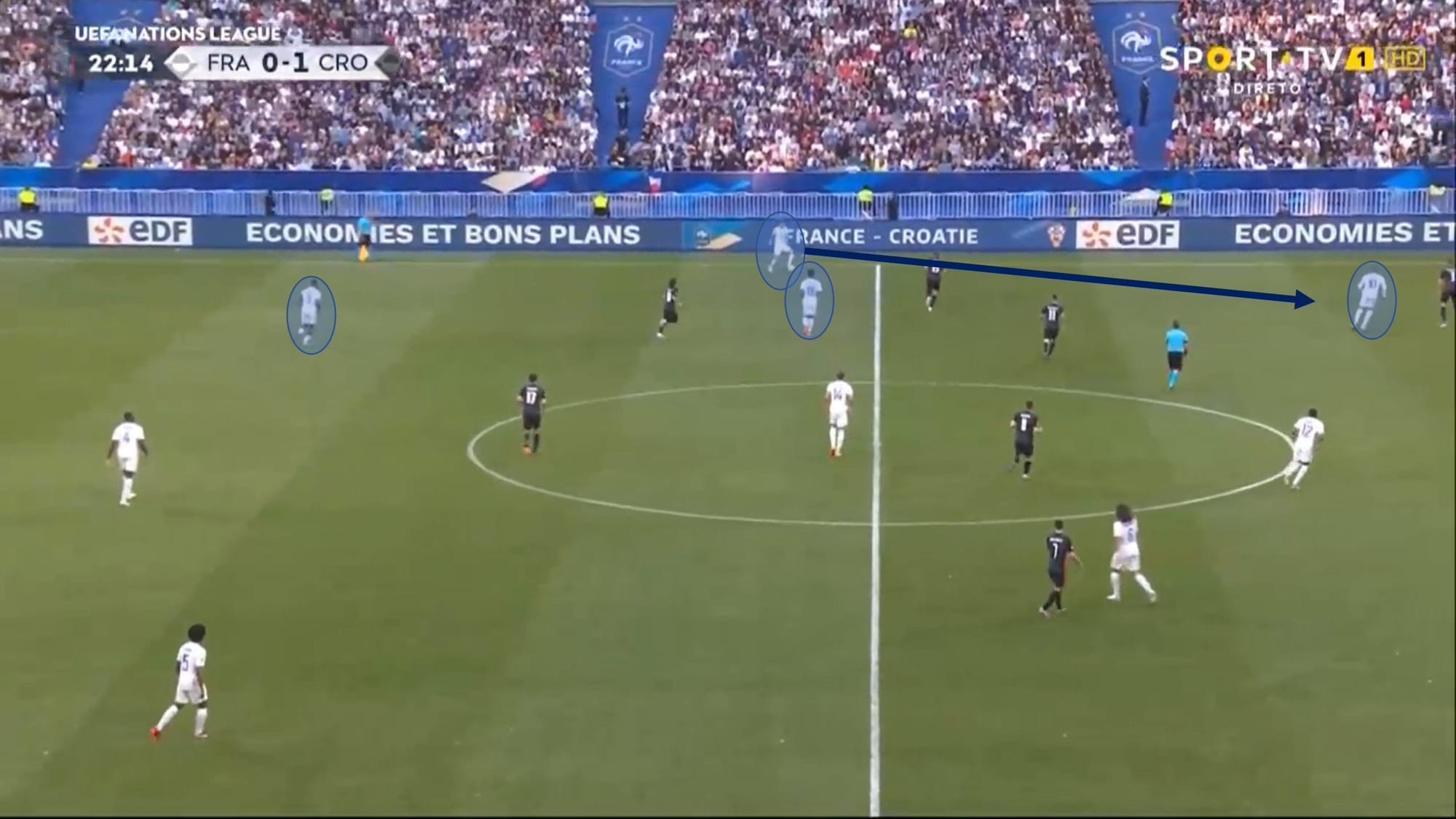
To progress the ball from this area, the obvious solution is to use the central midfielders or full-backs as France look to keep the ball on the floor, trying to go direct further up the field. In this instance, as Liverpool‘s Konate is on the ball, the two central midfielders are not even facing the play and are on the same horizontal line, which should be avoided as a pair in any part of the pitch. All the players look lethargic and slow to get on the ball which does slow the game down drastically giving the opposition time to recover.
France successfully progresses the ball when a central midfielder drops deep to pick up the ball, to turn at the opposition. It is least suited to the formations with two central midfielders. Here Real Madrid‘s Tchouaméni drops down for the ball off the same line as Kante. Here the more creative midfielders can progress the ball quickly for the team.
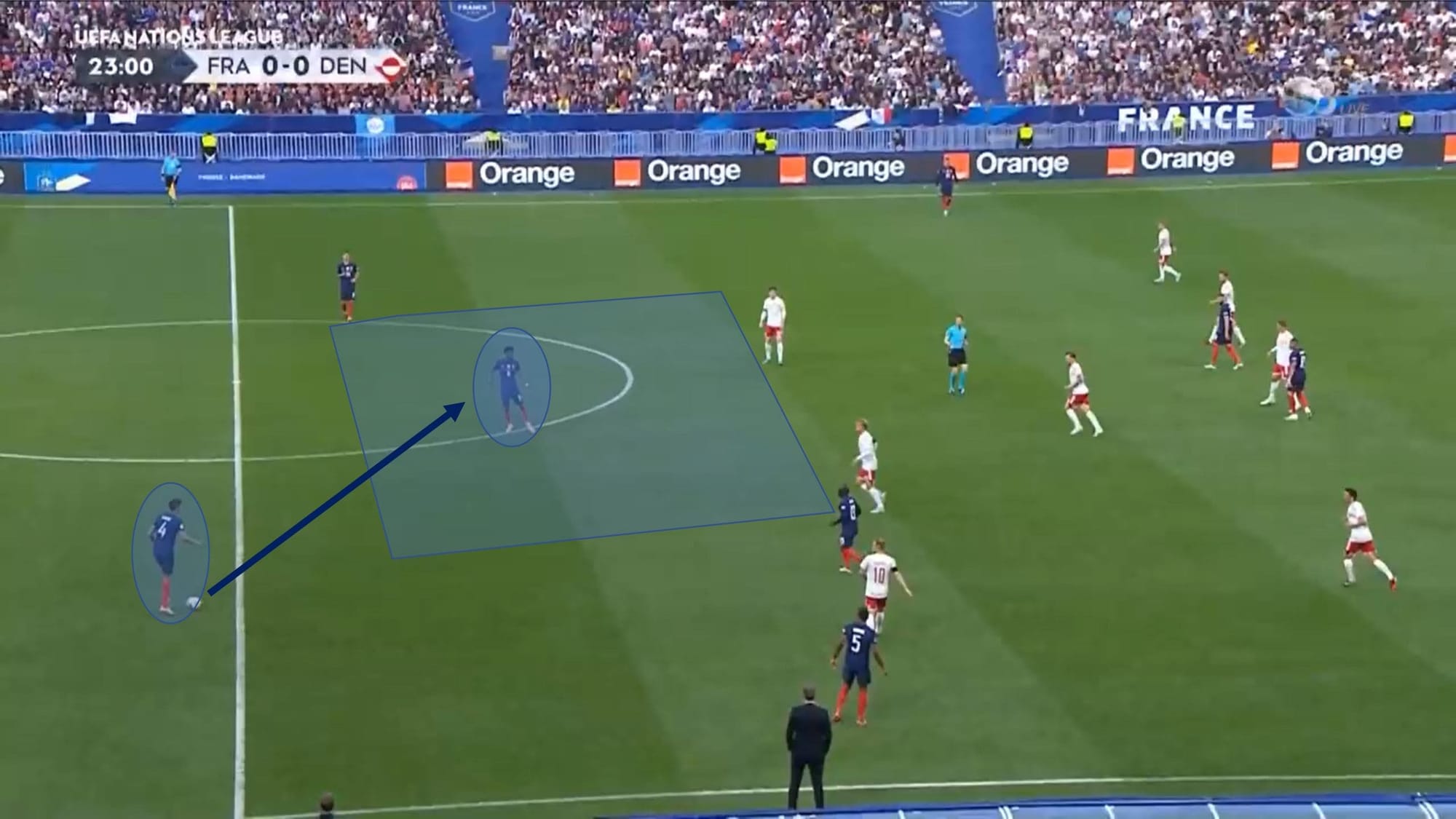
France are a possession team as they have averaged 57% of the ball over the four Nations League matches. France are happy to keep the ball as they average 6.8 passes per possession but often just pass the ball around the back. This gives the build-up less importance as they are progressing the ball with no danger to the opponent. However, it is definitely an area France can improve at if they had a system they all understood or rotations they could reliably execute.
In the final third, the lack of chemistry is clear in the team as the structure and the shape in this area of the pitch. France haven’t struggled for shooting opportunities as they have an average xG of 1.44 which they are underachieving with 0.75 goals per match. But, with 44.6% of their 14 shots a game outside the box, they don’t seem to be effectively using the attacking power they possess, especially as the top goal scorers in the world are struggling for goals in the team.
Highlighted by the snapshot from the match is the individualized nature of the creative output in the squad. Mbappe is on the ball having cut inside from the left-wing and is looking to find a progressive pass. The only two options for Mbappe are Guendouzi and Nkunku, with Guendouzi in no real position for the ball. There are no players in between the lines either that are usually in the position to pick up the ball and then progress it forward around the penalty area.
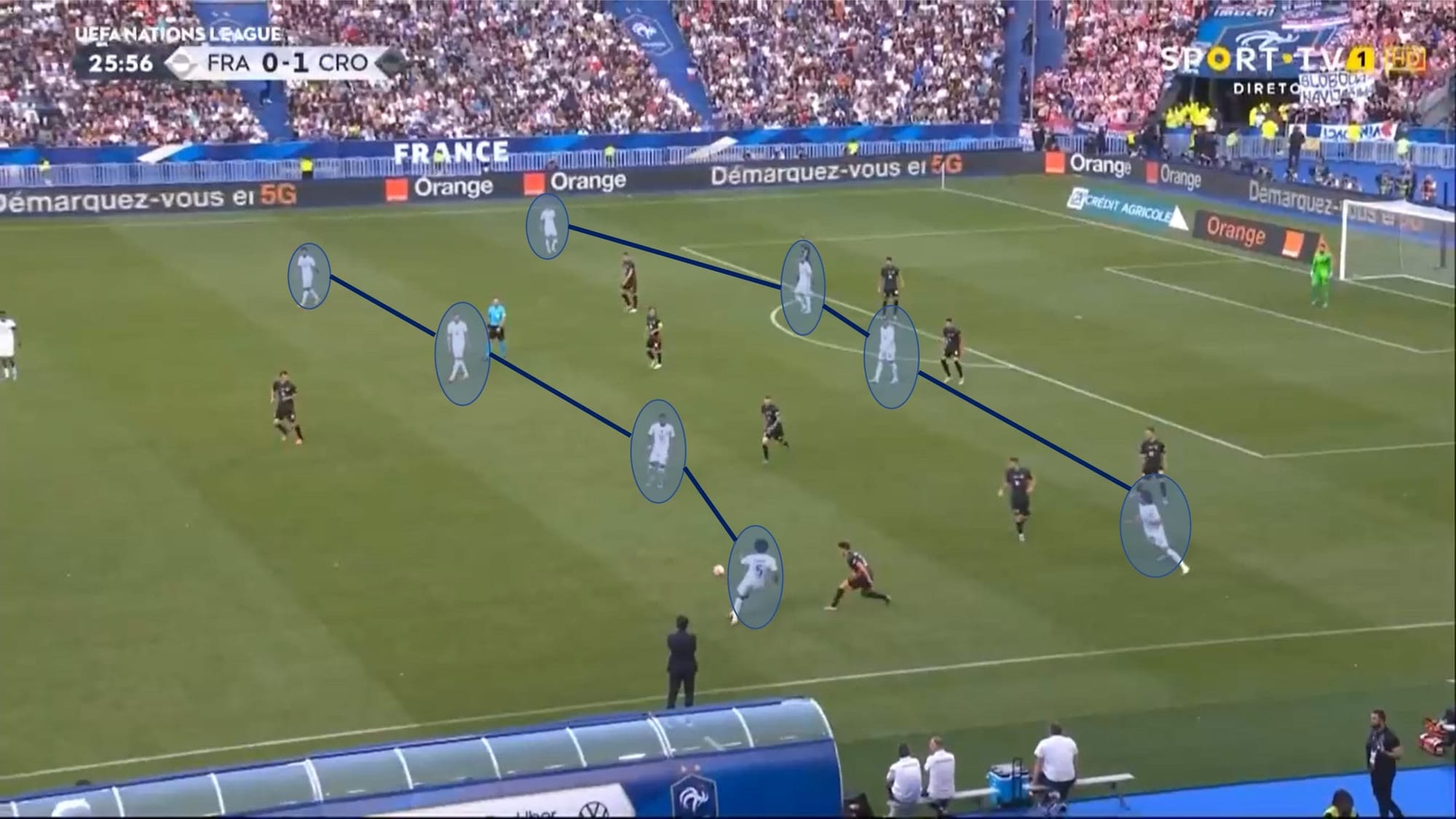
The two lines of four is lacking any forward endeavour and most of the payers look disinterested in getting the ball off Mbappe. France were playing a 4-2-3-1 in this match where there should be a number 10 in between the lines. But, the shape is more like a 4-4-2 with the full backs pushed high or a 3-4-1-2 with the wide midfielders forward and the attacking midfielder deep as a row of four. This is where there seems to be confusion between the different shapes which needs ironing out to increase the proficiency of the France attack, without any movement off the ball, creating chances on it is difficult.
Defence
In defence, the confusion between shapes is even more significant as the players drop into a structure to defend as a unit they often take the forms of the multiple formations that Deschamps cycles through. Because of the nature of football, structures are fluid in a match and will change depending on the specific circumstances. Therefore, it is difficult to put a finger on the root cause from the outside but with events reoccurring around the pitch, this may be a part of the problem.
In the Croatia match, France set up with a 4-1-2-3 with Kamara, Guendouzi and Rabiot making up the midfielder three. The shape often took the form of a 4-3-3 in the defence as the midfield remained flat and compact against the very strong Croatian central midfield of Modric, Brozovic and Kovacic.
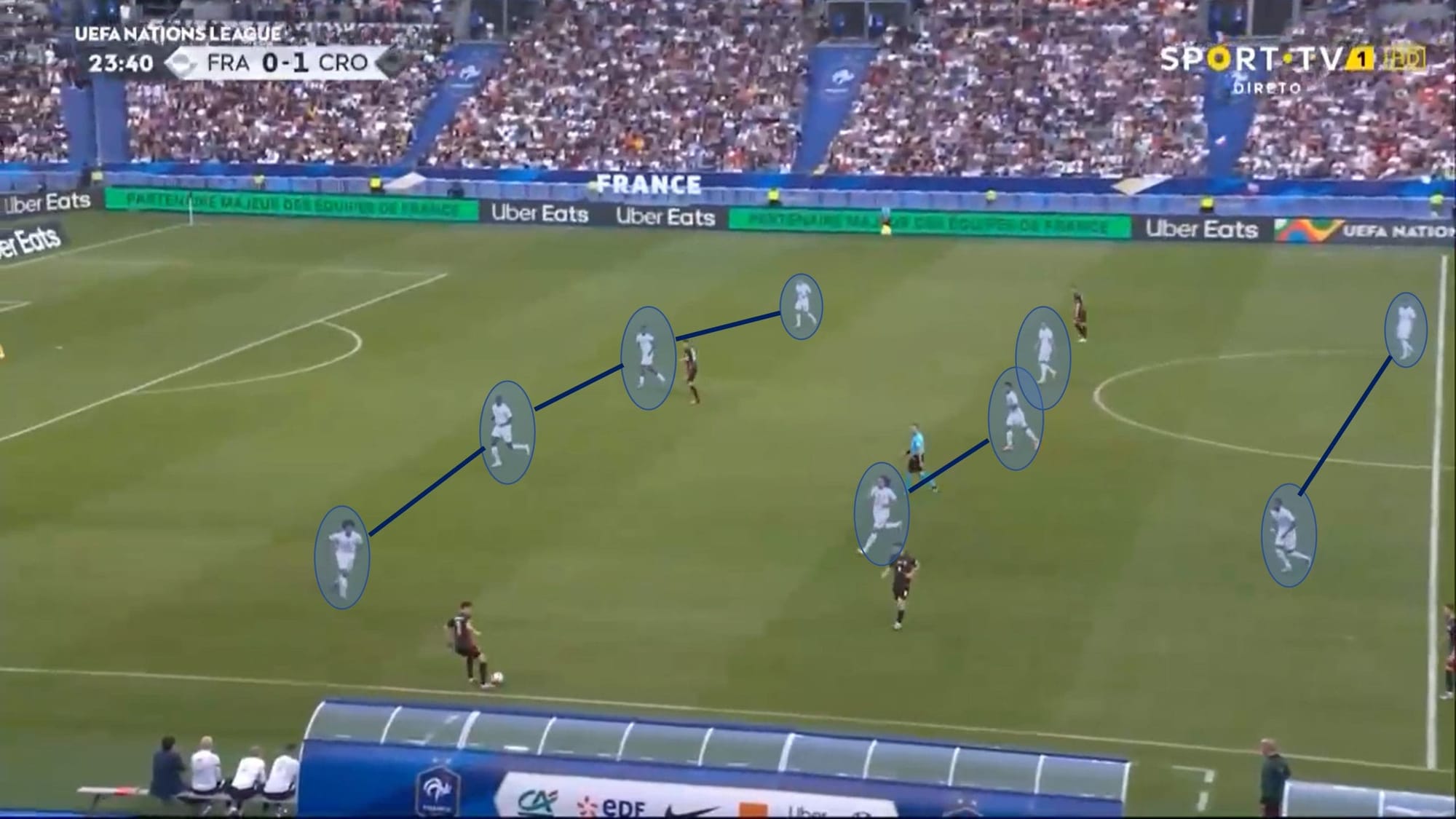
The defensive shape for France is often unstructured and prone to being moved about. As seen in the image below, the formation is currently a 5-1-4 with Mbappe playing as a left wing-back, while Guendouzi is part of a front four along with Rabiot, Nkunku and Benzema. The two main issues with a fluid defensive shape are that there is lots of space area the pitch as the gaps open as players are drawn to the ball and that players can be out of position for when France do win the ball.
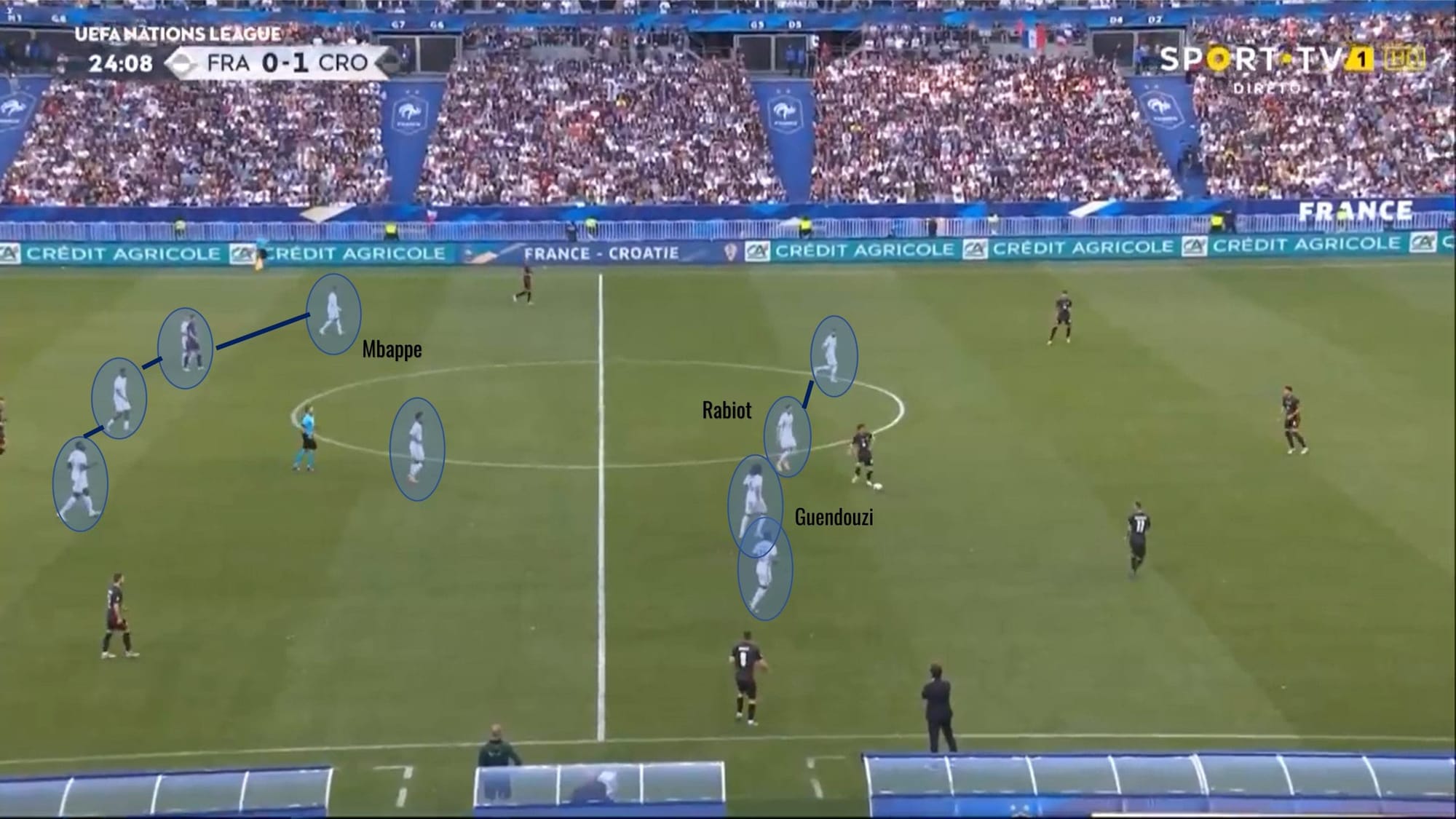
These rotations can be unnecessary for France as Croatia were able to execute their game plan with the knowledge the lack of structure would open up spaces in the defensive shape. In the short term it may not be an issue in games, but when it is frequently opening up your defence and players are rotated out of position, it can have effects on the offensive and defensive output of the team.
There may be a method to the multiple formations deployed by Deschamps as he may want his team to fluidly change between them making it difficult to break down France. France are not leaking lots of chances, as they only face 6 shots per match with 4 on target, but as they are conceding a goal in every match, there is something not working for them.
Even when there is a clear shape, France do not look solid or structured. Against Austria, the formation was a 4-2-3-1 but a 4-4-2 in defence as Griezmann looked to make another striker in defence. As often the case in a 4-4-2 there is lots of space in between the lines allowing the opposition to find pockets of space to exploit. This was certainly the case for France as Austria were unmarked between the lines.
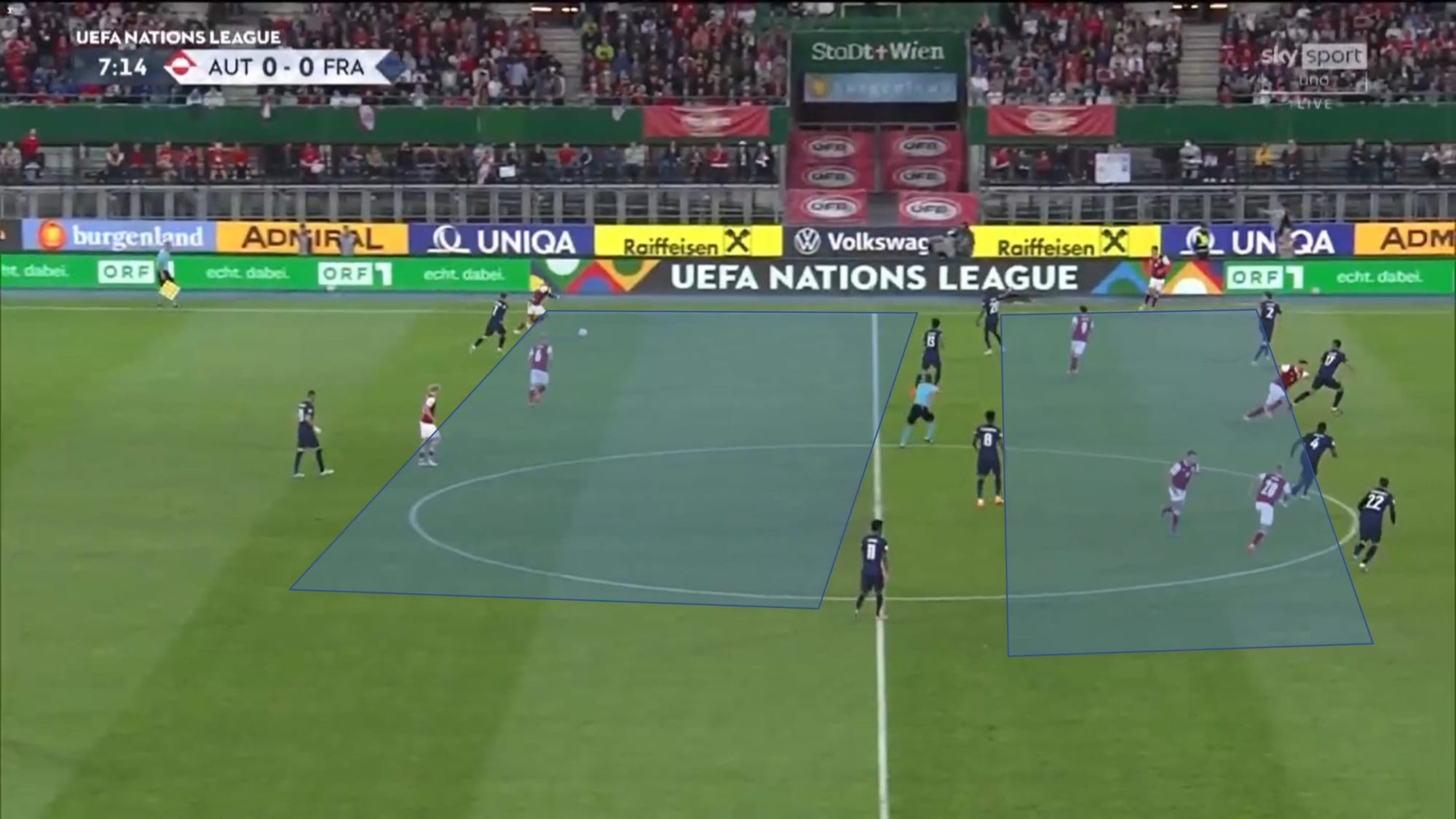
This was not only to do with the shape but also the communication in the team and the awareness of the players to make their zonally. Many of the French players have opposition players making runs behind them with them unknowingly marking the space.
The shape and structures all over the pitch need to be understood and worked on throughout all areas of the pitch for France as they look towards the World Cup in November. It affects both the offensive and defensive sides of the games, causing disorganization and confusion in the side. They must find a shape where the strengths of Benzema, Mbappe and the other star in attack for France can be maximized. The team look best when they can run at the opposition but when the runs start deep within their half, it provides the opposition time to get back or foul the player. In defence, they need to have a shape which everyone understands and can work for France as an entire unit.
Summary
No matter how France set up they will always be dangerous because of the talent within the squad, they need to find stability in both their starting eleven and formations to maximize their potential. That doesn’t mean that Deschamps shouldn’t search for the perfect formula, he should remain with one or two formations and look to drill that style into the players with the World Cup so close as he clearly has a few systems he is comfortable with the side playing in.
Deschamps is a manager who knows how to win the major international tournaments and is maybe planning already toward the World Cup. This could just be a goal drought but there is most likely something deeper than this problem. Once France do get a few wins they will be back to their best, but the biggest challenge for Les Bleus will be finding their feet before the World Cup in November.






Comments